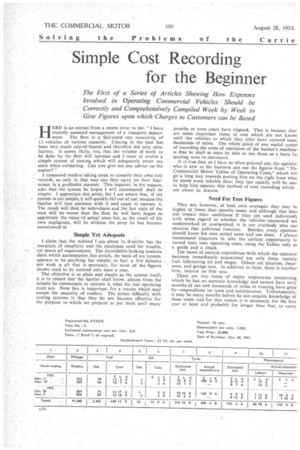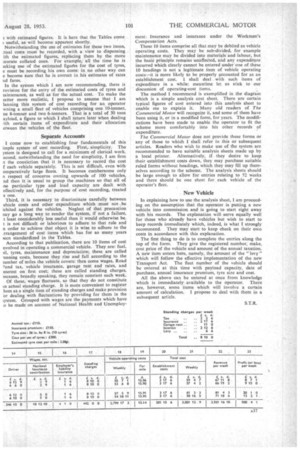Simple Cost Recording for the Beginner
Page 54

Page 55

If you've noticed an error in this article please click here to report it so we can fix it.
The First of a Series of Articles Showing How Expenses Involved in Operating Commercial Vehicles Should be Correctly and Comprehensively Compiled Week by Week to Give Figures upon which Charges to Customers can be Based
HERE is an extract from a recent letter to me: " I have recently assumed management of a transport department. The fleet is a fair-sized one consisting of 13 vehicles of various capacity. Costing in the past has been very much rule-of-thumb and therefore not very satisfactory. It seems likely, too, that the volume of work to be done by the fleet will increase and I want to evolve a simple system of costing which will adequately cover my costs when estimating. Can you give me any advice on the matter?"
I commend readers taking steps to compile their own cost records, as only in that way can they carry on their businesses in a profitable manner. This inquirer, in his request, asks that the system he hopes I will recommend shall be simple. I appreciate this point, for I am aware that, if the system is not simple, it will quickly fall out of use, because the haulier will lose patience with it and cease to operate it. The result will then be semi-chaos and the last state of the man will be worse. than the first; he will .have begun to appreciate the value of actual costs but, as the result of his own negligence, will be without the prop he has become accustomed to.
Simple Yet Adequate
claim that the method I am about to describe has the essentials of simplicity and the minimum need for trouble, yet meets all requirements, The formidable-looking analysis sheet which accompanies this article, the basis of my system, appears to be anything but simple; in fact, a few minutes per week is all that is necessary, for most of the figures shown need to be entered only once a year.
The objective is as plain and simple as the system itself; it is to ensure that the haulier shall know, almost from the minute he commences to operate it, what his real operating costs are. Now this is important, for a reason which may escape the majority of readers. The prime difficulty with costing systems is that they do not became effective for the purpose to which we propose to put them until many months or even years have elapsed. That is because ther are some important items of cost which are not knowi until the vehicles to which they refer have covered man! thousands of miles. The whole point of any useful systen of recording the costs of operation of the haulier's machine is that he shall at once be able to use them as a basis fo quoting rates to customers.
It is true that, as I have so often pointed out, the operato who is new to the business can use the figures from " Tht Commercial Motor Tables of Operating Costs," which wil go a long way towards putting him on the right lines whet he needs some reliable data: they can equally well be use to help him operate this method of cost recording which , am about to discuss.
Need For True Figures
They are, however, at best, only averages; they may bt higher or lower than specific cases, and although that doer not impair their usefulness if they are used judicious]) with some regard to whether the vehicles•concerned art underworked or ovenyorked, it is not everbody who can exercise that judicious function. Resides, every operator should know his own actual costs and use them. I always recommend inquirers to take the earliest opportunity to record their own operating costs, using the Tables only as a guide and a check.
The items of current expenditure with which the operator becomes immediately acquainted are only three, namely fuel, lubricating oil and wages. Others are taxation, ihsurance, and garage rent. In addition to these, there is another item, interest on first cost.
There are two items of major importance concerning which he has no accurate knowledge and cannot have unq months of use and thousands of miles of running have gone by—expenditure on tyres and maintenance. Unfortunately, it may be many months before he can acquire knowledge of these costs, and for that reason it is necessary, for the first year at least and probably for longer than that, to carry
with estimated figures. It is here that the Tables come useful, as will become apparent shortly. Notwithstanding the use of estimates for these two items, ;Mal costs must be recorded, with a view to dispensing ith the estimated figures, replacing them by the more :curate collated ones. For example, all the time he is taking use of the estimated figurts for the cost of tyres, e must be recording his own costs: in no other way can e become sure that he is correct in his estimates of rates rid fares.
In the system which I am now recommending, there is rovision for the entry of the estimated costs of tyres and taintenance, as well as for the actual cost. To make the latter more realistic, I propose to assume that I am lanning this system of cost recording for an operator wning a small fleet of vehicles comprising one 10-tonner, ne 8-tanner and two 6-tonners. That is a total of 30 tons ayload, a figure to which I shall return later when dealing rith certain items of expenditure and their allocation etween the vehicles of the fleet.
Separate Accounts I come now to establishing four fundamentals of this imple system of cost recording. First, simplicity. The ystem is designed to call for a minimum of clerical work. econd, notwithstanding the need for simplicity, I am firm 1 the conviction that it is necessary to record the cost f each vehicle separately. This is not difficult, even with omparatively large fleets. It becomes cumbersome only
• respect of concerns owning upwards of 100 vehicles, nd then it is usual to group the machines so that all of rte particular type and load capacity are dealt with ollectively and, for the purpose of cost recording, treated s one.
Third, it is necessary to discriminate carefully between ehicle costs and other expenditure which must not ,be lebited against the vehicles. Neglect of that precaution nay go a long way to render the system, if not a failure, t least considerably less useful than it would otherwise be. t is not difficult or laborious to adhere to that rule and n order to achieve that object it is wise to adhere to the .rrangement of cost items which has for so many years wen standardized in the Tables.
According to that publication, there are 10 items of cost nvolved in operating a commercial vehicle. They are: fuel, tit, tyres, maintenance and depreciation; these are called -unning costs, because they rise and fall according to the lumber of miles the vehicle covers: then come wages, Road 7und tax, vehicle insurance, garage rent and rates, and nterest on first cost; these are called standing charges, wcause, broadly speaking, they remain constant each week. Of these, wages fluctuate, so that they do not constitute in actual standing charge. R is more convenient to register hem as a single item of standing charges and make provision or dealing with fluctuations by providing for them in the tystem. Grouped with wages are the payments which have
o be made on account of National Health and Unemploy ment; Insurance and insurance under the Workmen's Compensation Acts.
These 10 items comprise all that may be debited as vehicle operating costs. They may be sub-divided, for example maintenance may be divided into materials and labour, but the basic principle remains unaffected, arid any expenditure incurred which clearly cannot be entered under one of these 10 headings is not a legitimate item of vehicle operating costs—it is more likely to be properly accounted for as an establishment cost. I shall deal with such items of expenditure in a while: meantime let us stick to our discussion of operating-cost items.
The method I recommend is exemplified in the diagram which is a simple analysis cost sheet. There are certain typical figures of cost entered into this analysis sheet to enable me to explain it. Many old readers of The Commercial Motor will recognize it, and some of them have been using it, or in a modified form, for years. The modifications have been made to enable the operator to fit the scheme more comfortably into his other records of expenditure.
The Commercial Motor does not provide these forms or any of those to which I shall refer in this or subsequent articles. Readers who wish to make use of the system are recommended to have suitable analysis sheets made up by a local printer. Alternatively, if they desire to keep their establishment costs down, they may purchase suitable ruled forms without headings, which they may fill up themselves according to the scheme. The analysis sheets should be large enough to allow for entries relating to 52 weeks and there should be one sheet for each vehicle of the operator's fleet.
New Vehicle
In explaining how to use the analysis sheet, I am proceeding on the assumption that the operator is putting a new vehicle into commission and is going to start right away with his records. The explanation will serve equally well for those who already have vehicles but wish to start to keep records immediately which, indeed, is what I strongly recommend. They may start to keep check on their own costs in accordance with this explanation.
The first thing to do is to complete the entries along the top of the form. They give the registered number, make, cost price of the vehicle and amount of the annual taxation. A new item enters here, namely, the amount of the " levy " which will follow the effective implementation of the new Transport Act. The fleet number of the vehicle should be entered at this time with payload capacity, date of purchase, annual insurance premium, tyre size and cost.
All the above can be entered at once from knowledge which is immediately available to the operator. There are, however, some items which will involve a certain amount of calculation. I propose to deal with them in a subsequent article.
S.T.R.




















































































